Ten most popular sushi neta varieties
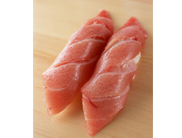
- 1Chutoro
(medium-fatty tuna)
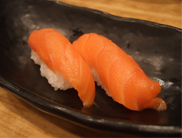
- 2Salmon
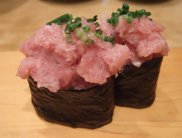
- Negitoro
(negi onion & fatty tuna)
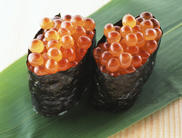
- Ikura (salmon roe)

- Uni(sea urchin)
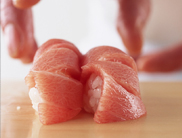
- Otoro
(very-fatty tuna)

- Anago (conger)
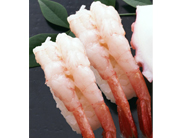
- Amaebi
(pink shrimp)
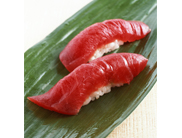
- Maguro (tuna)
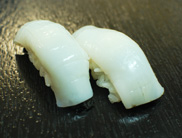
- Ika (squid)
Needless to say, sushi is the most significant dish that represents Japanese cuisine. Its popularity has spread so widely that the word sushi is recognized anywhere in the world today. Using untraditional ingredients such as avocado, cheese, or fried shrimp, international versions of sushi continue to evolve in a unique way to reflect local characteristics. Sushi has become a universal food that can be commonly enjoyed at sushi bars and restaurants outside Japan.
Many foreign tourists come to Japan with an expectation of trying an authentic sushi. Sushi is available in various styles and price ranges. At traditional sushi restaurants, sushi chefs directly take orders from customers at the bar and prepare food in front of them. Kaitenzushi is a more casual and reasonable version of the sushi restaurant where prepared sushi pieces are placed on small plates and are delivered on a conveyer belt through tables. Some sushi shops only sell packaged sushi to take home for reasonable prices.











A semi self-serve type of sushi restaurant features a conveyer belt that travels through tables and bar counters to deliver small plates of sushi to customers. Customers choose and take the plate of sushi they want to eat off the belt as it passes in front of them.
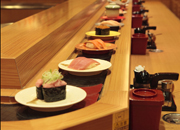
A variety of neta (mainly seafood), sliced for the size of nigirizushi, are colorfully arranged along with other ingredients on top of vinegared rice.
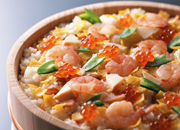
Aburaage (deep-fried thin tofu) is cooked in sweet and salty sauce and is filled with vinegared rice. Oinarisan, oinari, and inari all refer to the same dish.

Rice and other ingredients are layered and pressed for a while to shape. Oshizushi made with saba fish (mackerel) is very common, and local variations such as battera from Osaka and bozushi from Kyoto are both well known.
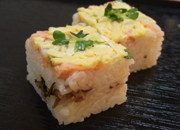
Typical norimaki (sushi rolls) are prepared by spreading vinegared rice over a sheet of nori seaweed, arranging such fillings as kanpyo strips and cucumber sticks on top of the rice, and rolling up the whole thing using makisu (bamboo roll mat). Depending on its size, sushi rolls are called hosomaki (thin roll), chumaki (medium roll), or futomaki (thick roll).
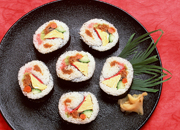
This American-style sushi roll is made with such ingredients as fake crab meat, avocado, mayonnaise, and white sesame, and is rolled by hand or in an uramaki style (a roll made so that the outmost layer becomes vinegared rice instead of nori sheet). A popular sushi menu at sushi restaurants overseas.
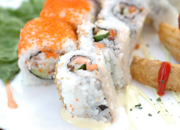
In Southeast Asia during the fourth century B.C., fish was fermented in a mixture of rice and salt for preservation purpose. It is believed that rice used for the mixture was not eaten and was discarded after use. This preservation method for fish was eventually introduced to Japan and became a dish called narezushi during the Heian period. Sometime during the Muromachi period, however, people began to save and eat rice of the mixture along with the fermented fish. During the Edo period, a quicker method was invented and was called hayazushi, which used vinegar instead of fermentation to make rice taste sour.
Nigirizushi (hand-shaped sushi) was first created in Edo during the late Edo period (early 19th century). Therefore, many Japanese people today think that Edomae-zushi refers to nigiri-style sushi invented in Edo, in comparison to Osaka-zushi, which refers to hakozushi (or oshizushi, box-pressed sushi). However, there was another meaning for its name that all seafood used for Edomae-zushi were freshly caught in the ocean in front (mae) of Edo.
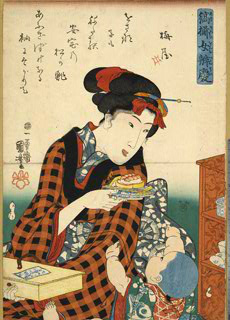
Some foreigners may be confused between sushi and sashimi and may think that they are a similar dish that uses raw fish. However, sushi is a different dish from sashimi in that it is always made with sumeshi, or vinegared rice. Sumeshi is actually an origin of the word sushi, and the sound of me gradually began to be omitted to become sushi. While there are many variations of sushi, including nigirizushi (a piece of seafood is placed on a bite-sized ball of vinegared rice), chirashizushi (a bowl of vinegared rice topped with a variety of seafood), and makizushi (seafood and vinegared rice roll wrapped with a sheet of nori seaweed), sushi always refers a combination of seafood and vinegared rice.